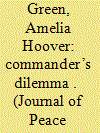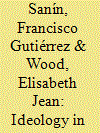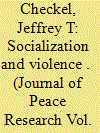|
|
|
Sort Order |
|
|
|
Items / Page
|
|
|
|
|
|
|
| Srl | Item |
| 1 |
ID:
147832


|
|
|
|
|
| Summary/Abstract |
This article proposes a framework for understanding variation in armed groups’ abilities to control wartime violence, including violence against civilians. I argue that patterns (both levels and forms) of violence are shaped by armed group leaders’ attempts to meet two conflicting imperatives. To succeed, commanders must build a fighting force capable of swift, unhesitating violence; they must also maintain some control over the level, form(s), and targeting of violence. I refer to this situation as the Commander’s Dilemma. Drawing on literatures from psychology and sociology, I argue that effective behavioral control cannot be achieved via extrinsic incentives (i.e. pecuniary or non-pecuniary rewards and punishments) alone. Rather, effective control of combatant violence depends upon armed group institutions intended to align combatants’ preferences with those of commanders. I therefore focus analytically on political education, the armed group institution most likely to operate in this way. In particular, I hypothesize that armed groups with strong and consistent institutions for political education should display, on average, narrower repertoires of violence than those without. This argument finds preliminary support in a cross-national analysis of reported rape by rebel forces, as well as a qualitative investigation of armed groups during civil war in El Salvador. More broadly, this approach suggests that the creation of restraint is at least as important to our understandings of wartime violence as the production of violence.
|
|
|
|
|
|
|
|
|
|
|
|
|
|
|
|
| 2 |
ID:
128868


|
|
|
|
|
| Publication |
2014.
|
| Summary/Abstract |
How important is ideology for the analysis of civil war? In contrast to literature that neglects ideology in its emphasis on structural variables or situational incentives, this article argues for the recognition of its essential role in the functioning of armed groups if they are to explain observed variation in armed group behavior. For example, sidelining ideology leaves major phenomena unexplained, including both mass killing and restraint in violence against civilians. Ideology is defined as a set of more or less systematic ideas that identify a constituency, the objectives pursued on behalf of that group, and a program of action (perhaps only vaguely defined). Ideology matters in two ways. First, it has instrumental value for armed groups, socializing combatants with heterogeneous motivations into a coherent group, dampening principal-agent problems, prioritizing competing goals, and coordinating external actors including civilians. Ideologies differ in the kind of institutions and strategies they prescribe for meeting these challenges and in the extent to which they do so. Yet this first approach is incomplete, as ideology has more than instrumental value. Members of some armed groups act on normative commitments in ways not reducible to instrumental reasoning, and some groups constrain their strategic choices for ideological reasons, often normative concerns prescribed by their ideology. Some groups, for example, engage in restraint, declining to use violence though it would have strategic benefit. The conclusion lays out a twin-fold research agenda: a 'weak program' that analyzes the instrumental adoption of ideology and a 'strong program' that explores normative commitments based on particular ideologies and on social preferences.
|
|
|
|
|
|
|
|
|
|
|
|
|
|
|
|
| 3 |
ID:
155194


|
|
|
|
|
| Summary/Abstract |
This article sets the stage for a special issue exploring group-level dynamics and their role in producing violence. My analytic focus is socialization, or the process through which actors adopt the norms and rules of a given community. I argue that it is key to understanding violence in many settings, including civil war, national militaries, post-conflict societies and urban gangs. While socialization theory has a long history in the social sciences, I do not simply pull it off the shelf, but instead rethink core features of it. Operating in a theory-building mode and drawing upon insights from other disciplines, I highlight its layered and multiple nature, the role of instrumental calculation in it and several relevant mechanisms – from persuasion, to organized rituals, to sexual violence, to violent display. Equally important, I theorize instances where socialization is resisted, as well as the (varying) staying power of norms and practices in an individual who leaves the group. Empirically, the special issue explores the link between socialization and violence in paramilitary patrols in Guatemala; vigilantes in the Bosnian civil war; gangs in post-conflict Nicaragua; rebel groups in the Democratic Republic of Congo, El Salvador, Sierra Leone and Uganda; post-conflict peacekeepers; and the US and Israeli military. By documenting this link, we contribute to an emerging research program on group dynamics and conflict.
|
|
|
|
|
|
|
|
|
|
|
|
|
|
|
|
|
|
|
|
|